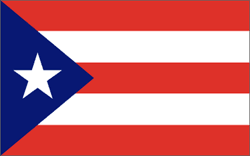The Commonwealth of Puerto Rico is located in the Caribbean Sea, about 1,000 mi east-southeast of Miami, Fla. A possession of the United States, it consists of the island of Puerto Rico plus the adjacent islets of Vieques, Culebra, and Mona. Puerto Rico has a mountainous, tropical ecosystem with very little flat land and few mineral resources.
Puerto Rico's governor is elected directly for a four-year term. A bicameral legislature consists of a 27-member Senate and a 51-member House of Representatives, all elected for four-year terms. From 1940 to 1968, Puerto Rican politics was dominated by a party advocating voluntary association with the U.S. Since then, the New Progressive Party, a party favoring U.S. statehood, has won five of the last eight gubernatorial elections. Puerto Ricans have twice voted to determine their political status. In 1967, the outcome was Commonwealth 60%; statehood 39%; independence 1%. In 1993, Commonwealth dropped to 48.6%; statehood rose to 46.3%; independence polled 4.4%; and 0.6% of the ballots were blank or spoiled.
Under the Commonwealth formula, residents of Puerto Rico lack voting representation in Congress and do not participate in presidential elections. As U.S. citizens, Puerto Ricans are subject to military service and most federal laws. Residents of the Commonwealth pay no federal income tax on locally generated earnings, but Puerto Rican government income-tax rates are set at a level that closely parallels federal-plus-state levies on the mainland.
When Christopher Columbus arrived there in 1493, the island was inhabited by the peaceful Arawak Indians, who were being challenged by the warlike Carib Indians. Puerto Rico remained economically undeveloped until 1830, when sugarcane, coffee, and tobacco plantations were gradually developed. After Puerto Ricans began to press for independence, Spain granted the island broad powers of self-government in 1897. But during the Spanish-American War of 1898 American troops invaded the island and Spain ceded it to the U.S. Since then, Puerto Rico has remained an unincorporated U.S. territory. Its people were granted American citizenship under the Jones Act in 1917; were permitted to elect their own governor, beginning in 1948; and now fully administer their internal affairs under a constitution approved by the U.S. Congress in 1952. In spite of broad popular support for the autonomy of the Commonwealth government and a rapidly modernizing industrial society, there were expressions of dissatisfaction. Puerto Rican extremists dramatized their desire for independence with an attempt to assassinate President Truman on Nov. 1, 1950, and on March 1, 1954, they wounded five congressmen in an attack on the U.S. Capitol.
A self-help program of economic development and social welfare (called “Operation Bootstrap”) was forged in the 1940s by four-time governor Luis Muñoz Marín. In a little more than four decades, much of the island's crushing poverty was eliminated. This was done partly through the development of manufacturing and service industries, the latter related to an enormous growth in tourism. Also, many Puerto Ricans migrated to large cities on the mainland U.S.
Puerto Rico is a major hub of Caribbean commerce, finance, tourism, and communications. San Juan is one of the world's busiest cruise-ship ports, and Puerto Rico's standard of living continues to be among the highest in the Western Hemisphere. Its future political status, however, remains unclear. On March 4, 1998, the U.S. House of Representatives passed a bill that called for binding elections in Puerto Rico to decide the island's permanent political status.
Since the 1940s, the U.S. Navy had used Vieques island as a bombing range. Protests against the exercises grew in recent years, and in a July 2001 referendum, residents of the island voted overwhelmingly to close the base. The navy withdrew from Vieques in May 2003.
The Nov. 2, 2004, gubernatorial elections led to a two-month recount and a court challenge. On Jan. 2, 2005, Aníbal Acevedo Vilá of the Popular Democratic Party was declared governor. He received 48.4% of the vote, and his main challenger, Pedro Rossello of the New Progressive Party, 48.2%. Acevedo supports the existing U.S. territorial status of the island; Rossello supports statehood for Puerto Rico.
In May 2006, a political standoff led to a two-week-long budget crisis resulting in the partial shutdown of the government, including all public schools. More than 100,000 workers went without pay.
On November 4, 2008, Luis Fortuño became the ninth Governor of Puerto Rico. Fortuño won by more than 220,000 votes, the largest margin in 44 years. In June 2011, Fortuño announced that he would run for re-election.
On November 6, 2012, Puerto Rico will hold a referendum on independence, statehood, or to remain in territorial status. The vote will happen on the same day as the general election. This is the fourth referendum on Puerto Rico's political status. The previous ones, held in 1967, 1993, 1998, have all resulted in favor of remaining in territorial status.










